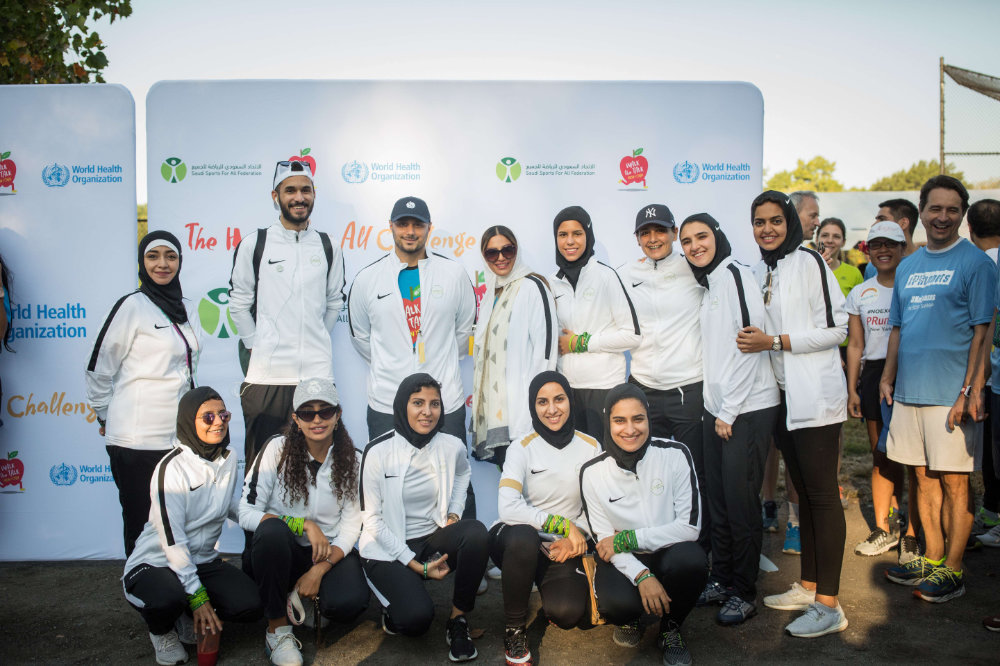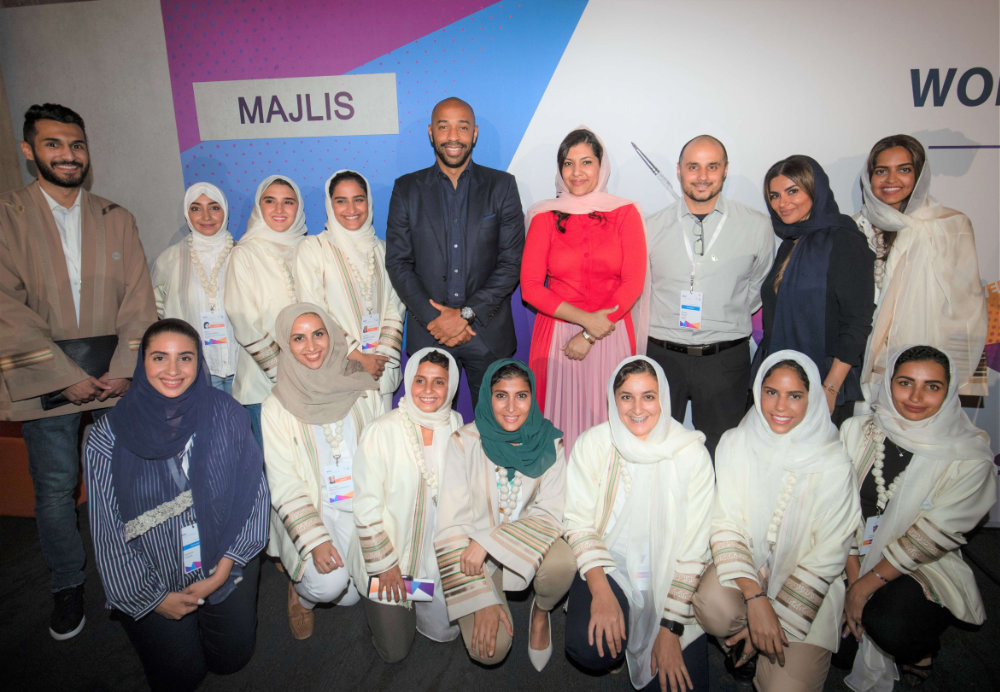JEDDAH: Women’s sport in Saudi Arabia is flourishing, with Ministry of Sports estimates showing that female participation has increased by nearly 150 percent in the past five years.
From beginners to fitness fans, women are discovering and benefiting from the perks of an active and healthy lifestyle.
This surge in interest can be attributed to many factors, including better knowledge of healthy lifestyles, increased opportunities to take part in activities, and a growing number of inspirational role models.
Under Vision 2030, and specifically the Quality of Life program, the Saudi Sports for All Federation (SFA) is working to increase weekly sports participation to 40 percent by 2030, by introducing a more inclusive sports environment, and encouraging girls and women to take up a sport.
SFA President Prince Khaled bin Alwaleed bin Talal said: “Championing a healthy and active community means that we help to provide all members of Saudi society with access to high-quality opportunities to discover their love of fitness.”
He added: “The SFA is mandated with increasing participation in physical activity, and with women leading this national drive we are well positioned to meet the goals outlined by Vision 2030, closely supported by the Quality of Life program, the Ministry of Sports and the Saudi Arabian Olympic Committee.”
In February, the SFA inaugurated the Kingdom’s first Women’s Football League (WFL) to meet the need for community-level football.
“Having a women’s football league is a huge boost for female football. We have been playing football, forming leagues and training since 2007, without any tangible support,” said Rawh Abdullah Alarfaj, the SFA’s special projects manager.
“This is an opportunity for players of every level who are looking for an organized league under an official umbrella, and for coaches and referees who need to be recognized. The league also offers a great structure for clubs who have been established for a long time but have struggled to run effectively due to limited access to equipment, a field or a proper system where they can compete fairly. This league will open doors for any woman who has an interest in football.”

Football is the most popular sport in the Arab world in general and Saudi Arabia in particular, and the WFL — the nation’s first women’s football league to meet the need for grassroots football — is open to women aged 17 and above. (Supplied)
Football is the most popular sport across the Kingdom, and the WFL — the nation’s first community women’s football league to meet the need for grassroots football — is open to women aged 17 and above.
The launch of the WFL followed the success of the Saudi Greens women’s football team, another initiative overseen by the SFA. Formed in 2018, the Saudi Greens competed in the UN Global Goals World Cup 2019 (GGWCP), where they claimed second place. It was the first time a Saudi women’s community sports team had taken part in an international event.
On representing her country overseas, coach Maram Adel Albutairi said: “It was an awesome experience in terms of learning how to connect our passion for sport with goals that affect our society, country and the world. Being part of the first team to compete internationally was an honor and a dream come true.”
Fellow coach Lujain Kashgari described her pride at Saudi Arabia’s achievements, starting at the community sports level. “The SFA makes huge efforts to use sports as a power to encourage society to develop a healthy and fit lifestyle,” she said.
Roaa Qattan, Albutairi and Kashgari are the only three female Saudi football coaches certified by the AFC and have attended specialized training courses in football coaching. They have been selected to lead the Arabic training sessions as part of the international GGWCP Virtual Clubhouse, which ran online until July 9.
Qattan said the Virtual Clubhouse offers an excellent opportunity to join the Green Team in its current Arabic training sessions.
BACKGROUND
Under Vision 2030, and specifically the Quality of Life program, the Saudi Sports for All Federation is working to increase weekly sports participation to 40 percent by 2030.
“Albutairi, Kashgari and I were selected and tasked with preparing content for the training sessions in a way that was easy to set up and using simple Arabic. I wouldn’t be able to succeed without the support of the Green Team members and the SFA management, which is committed to achieving the General Sports Authority goals under Vision 2030.”
Saudi women are starting to show what they can achieve in sports.
Osamah Saleh, SFA director of marketing and communications, said: “With investment at a local level, positive role models and continued support from the SFA in the form of innovative campaigns and events, the rise of female Saudi sports stars will be unstoppable.
“We know the sport is about much more than excelling. Everyone has their personal goal — from increasing their step count to committing to exercising three times a week — and the SFA is there to help women at the critical community and grassroots level.”
To maintain momentum in the face of the coronavirus pandemic, the SFA promoted a “Your Home, Your Gym” campaign, aimed at encouraging people to get active while they stayed at home. Leading sports personalities were recruited as ambassadors, including leading female trainers to engage more women and offer home workout options.
The SFA also held the first Saudi Women’s Fitness Festival (WFF) in June — a three-day virtual event with sessions on nutrition, fitness, virtual workouts and thought leadership discussions.
Yasmine Hassan from Jeddah, one of the new wave of Saudi fitness coaches building online followings, said that an invitation to become an SFA ambassadors meant a lot.
“Collaborating with entities such as the SFA means I can continue to grow and improve myself, both personally and professionally. I enjoy challenges and look forward to opportunities where I can
share my experience. Sport is a lifestyle and I want to encourage everyone, especially women, to get active.”
Hatoon Kadi, a WFF panel moderator, blogger, scriptwriter and presenter of YouTube’s “Noon Al-Niswa,” said the festival provided a great opportunity for women and girls to hear directly from female sporting role models.
“Being active and playing sports is beneficial for both mental and physical well-being, but now it can also become a career. The Women’s Fitness Festival provided the opportunity to hear first-hand how women who are already successful in their chosen sport combine fitness with motherhood, how they have overcome certain barriers, and how they got started on their fitness journey.”
Najia Al-Fadl, head trainer at Jeddah’s SheFit gym, also took part in a WFF panel discussion.

Football is the most popular sport in the Arab world in general and Saudi Arabia in particular, and the WFL — the nation’s first women’s football league to meet the need for grassroots football — is open to women aged 17 and above. (Supplied)
“There are more clubs for girls these days and more are on the way, which is good progress,” she said. “We have to support women who want to take up a sport, whether it is a hobby, a lifestyle or a career. There have been so many changes in recent years and now there are a lot more opportunities, thanks to the SFA.”
In March, the SFA launched Girls’ National Sports Days (GNSD) in the Kingdom, which ran over a six-week period with 24,000 students from 499 schools taking part.
The program’s lead coach has more 25 years’ experience in delivering and developing the program globally, as well as the pilot project in Saudi Arabia in 2018.
Designed to achieve the Vision 2030 Quality of Life goals of enhancing girls’ sports participation within schools and promoting female inclusion in sport, the program is designed to encourage students to improve their health, fitness and sports participation, while giving participants the chance to experience different sports.
“From the girls’ smiles, laughter and chanting as they cheered on their teammates, it was clear that they all thoroughly enjoyed the Girls’ National Sports Days,” said Kirsten Butler, the project director.
By encouraging sports from a young age for girls, Saudi Arabia will become a healthier, stronger country, she said.
From these SFA-led initiatives, it is clear that women are eager to become more involved in sport. Whether providing opportunities at the community and grassroots level, establishing leagues, or working with female role models, the SFA is laying a solid foundation that encourages women from all walks of life to take up sport.


















